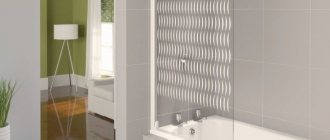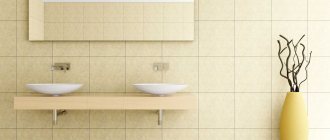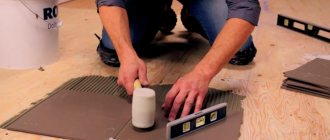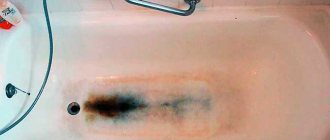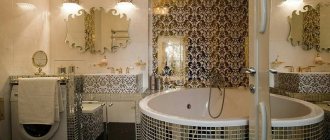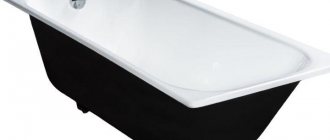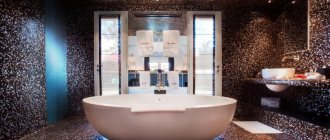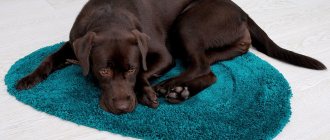One of the seemingly insoluble problems that arise when renovating a bathroom has always been and remains the problem of arranging the floor and flooring in the room. For a concrete base, the choice of floor finishing options is quite large; you can use traditional tiles or even warm floors, but what to put on a wooden floor in the bathroom, given the fact that wood and water have been and remain irreconcilable opponents?
What should be the flooring in the bathroom?
Almost any good quality wooden floor has a universal character; it can be installed in any residential building, be it a house or an apartment, a cottage or a guest house, except for a bathroom. Putting a simple wooden covering in a bathroom means it will rot in a few months. Therefore, it is necessary to change the structure of the floor, for example, lay an additional layer of plastic or ceramic on a waterproof base, or use a material for a wooden floor that is not susceptible to the destructive effects of water.
But, before laying decorative tiles or any other floor finishing option, it is worth considering some specific qualities of the wooden base:
- It will be necessary to strengthen the floorboards, which sag under the weight of a person, even if plywood or OSB sheets are placed on top of them. The deflection may not be noticeable during daily use, but it becomes obvious the first time you try to lay hard tiles;
- A wood base is not the best option for a floor; in addition to the fact that it needs to be protected from rotting, the structure of the material can change in size even with the slightest change in humidity, not to mention the fact that wooden floors can simply arch in the humid atmosphere of the bathroom ;
- All of the above is a serious problem that has to be solved. For example, when arranging a bathroom in a wooden house where there are no concrete floors, the floorboards lying on the beams are, at best, protected by a layer of basalt thermal insulation. In such conditions, it is not enough to put a waterproofing layer; you will need to carry out a whole range of protective measures.
Therefore, no matter what material you plan to put on a wooden base, the bathroom floor must be protected from water by all available means, namely:
- Lay a double layer of waterproofing;
- Thermally insulate wooden parts from sources of water vapor;
- Provide high-quality ventilation for the subfloor, with air intake from the nearest dry room.
If you simply lay down a decorative coating with waterproofing, then due to the water vapor accumulating in the space around the wooden floorboards, even under the waterproofing layer, the wood will rot and rot.
Advice! Instead of ventilation ducts, several kilograms of powder with good absorption of water vapor can be placed under wooden floors. This will help remove most of the water and protect the insulation from waterlogging.
It is the leakage of water vapor through the corner seams that causes rapid failure of the insulation. Paired with an absorber, you can safely put crushed expanded clay or even mineral wool. All this will make wooden floors not only durable, but also safe.
Oddly enough, there is another way to preserve wood, for example, by installing a heating system in the base of the floor. Any heated floor on a wooden base in the bathroom can be used not only for heating, but also for drying some of the condensation and remaining water on the surface of the floorboards.
Type of wood used
The main condition for wood coverings is not to be exposed to moisture and temperature changes.
Hard teak
The compacted structure of wood not only does not allow moisture to pass through, but also has the ability to accumulate heat. Resistant to the influence of household chemicals and does not wear out.
Thermowood
This is an original technology that produces material that is many times greater than:
- water resistance;
- resistance to rotting;
- prevents the appearance of fungus and mold;
- cannot be deformed.
Larch
Covering from larch is cheaper than from teak, but in terms of its qualities it is no worse than teak. Larch is a durable and water-resistant species. It was not without reason that it was used in shipbuilding.
You need to purchase boards that are connected according to the “groove to tongue” principle. There is also a term for such lumber: “finished floor board”. This connection will provide a strong and reliable connection.
What modern materials can be placed on wood in the bathroom?
There are not many options for flooring that can be used in the humid atmosphere of a bathroom, since material manufacturers focus primarily on concrete bases, which are the most common in modern house construction.
If you exclude the most extreme method of dismantling the wooden floor, boards and joists, you can put a covering on the floor in three basic versions:
- Screed the wooden bathroom floors and lay tiles;
- Lay waterproof laminate or linoleum;
- Leave the old plank version as the subfloor of the bathroom, on top of which lay a wooden panel made of moisture-resistant wood.
For your information! A wooden floor, made using modern tracing paper from traditional and new materials, has stunning beauty, while in terms of durability and consumer qualities it is not inferior to ceramics and plastic.
Classic wooden flooring in the bathroom
To avoid problems with warping and rotting of wooden structures, the floor in the bathroom is made in the image and likeness of the structure used in the steam room of a bathhouse or the deck of a fishing schooner. In fact, the wooden floor is double:
- The lower subfloor is also called wet; it collects all the water, dirt and residual detergents that fall on the bathroom floor;
- The upper wooden floor should be made from waterproof types of wood, preferably ash or oak.
Larch is considered to be the most resistant, but in practice there are not many people who want to install and walk on a dark and not very attractive surface in the bathroom, so bleached and tinted oak is best suited.
The lower subfloor must be thoroughly waterproofed. To do this, you can use liquid rubber as the first layer, or a special coating butyl-styrene waterproofing used to insulate the bowls of swimming pools, ponds and large concrete tanks.
If the subfloor is made of boards, then before installing waterproofing, it is necessary to sew the floorboards at the joints with nails or screws, remove the paint and sand the surface with coarse sandpaper.
The base of the subfloor is impregnated with an antiseptic and thoroughly dried. If the base is concrete, then you will need to insulate the bathroom floor with polystyrene foam, lay down moisture-resistant plywood, install support joists for the finished wooden floor in the bathroom, and only after that apply coating waterproofing.
After the insulation layer has dried, all that remains is to lay the top finishing floor. Pre-planed boards treated with waterproof varnish are laid on joists on tenons or wooden pins. You cannot hit nails or screw screws into wood. Even if you put a layer of protective varnish on top, the attachment points will rust.
The result is a very beautiful and durable bathroom floor.
Popular questions
How to cover a larch floor in a house
To choose the right coating, you need to consider what results a particular composition gives. It is also important to take into account the nature of the further use of the floor.
Appearance of the final floor covering
You shouldn’t just divide products into varnish and oil. Most often, the former create a film, and the latter are a natural material. However, you can find varnish that is almost invisible on the wood, and oil that creates a noticeable film.
How much does it cost to sand a larch floor?
The cost of renewing the floor depends on the degree of damage that occurred during operation. The surface is treated with a special machine equipped with a dust collector, which collects fine dirt. The price of sanding starts from 300 rubles per square meter of floor.
Flooring made from larch boards, despite its high cost, remains popular. In addition to being environmentally friendly, wood has many advantages. Using larch, you can lay a reliable, warm, beautiful floor that will last for decades.
Did the article help you? ( 15 ratings, average: 4.00 out of 5)
Wood finish options for bathroom floors
The age-old problem of how and what to put on the bathroom floor can be solved in a fairly simple way. To create the most beautiful, warm and environmentally friendly coating, you only need to use special types of wood-based materials or waterproof wood species:
- Larch;
- Oak;
- Ash;
- Thermostatic wood.
All of the listed types of wood cope well with water. You only need to waterproof the base using coating mastic and lay a thick plastic film. The wooden floor can be laid on slats or glued directly to the base.
To prevent moisture from seeping through the joints, molten mastic based on pine resin is poured into the seams. Next, you will need to put a fiber cord into the joints and fill the seams with polyurethane varnish or epoxy glue. The service life of a wooden floor in a bathroom is at least 10 years.
Final recommendations
In conclusion , it is worth noting that properly assembled and painted ceilings do not require complex maintenance. To preserve their decorative properties and extend their service life, it is enough to periodically wipe them with microfiber or pieces of soft textile dipped in polish.
Abrasive materials and aggressive detergents cannot be used for these purposes. In addition to cleaning, wooden ceilings are periodically inspected to check the condition of structures and surfaces; any detected defects (warping of rows, cracks, peeling paint, the appearance of fungal lesions) are immediately eliminated.
Now you know the answer to the question: a wooden ceiling in an apartment, the pros and cons, what is best to make it from, installation and painting technology.
Wooden floor and ceramic tiles
Wooden flooring in the bathroom is not designed for heavy loads; wood can be laid on the floor only for large bathrooms where there is good ventilation and airing of the room, ensuring the effective removal of water vapor and surface moisture.
If the dimensions of the room are within 2x3 m, or the room is used quite often so that the moisture on the walls and floor does not have time to dry out, in this case it is best to lay tiles. Laying tiles over a wood bathroom floor will require significantly more effort and expense, but it is the only way to make the most durable bathroom floor possible.
If it is important for the room to maintain the appearance of a wooden floor, you can select and lay porcelain tiles with imitation parquet or floorboards. To ensure that the seams do not reveal the real origin of the flooring material, you will need to lay tiles with a seam width of 0.5-0.8 mm. In this case, it will look like real floorboards.
The bathroom is lined with clapboard, pros and cons
Lining, as a finishing material, has its advantages and disadvantages. One of its distinctive advantages is its low cost. Compared with standard tiles, plastic panels have an affordable price, accessible to a wide range of consumers.
Installation of the panels is quite simple; even people with minimal basic repair skills can do it.
Lining is a moisture-resistant material that does not absorb moisture, which is its undeniable advantage, allowing it to be used in finishing bathrooms.
In a room finished with plastic, you can install integrated spot lighting, which allows you to create maximum illumination in every corner.
It is worth noting! This material does not require special care, just wiping with a damp cloth is enough.
Unlike ceramic tiles, the structure of PVC finishing material is more heat-containing, which prevents or minimizes the formation of condensation on the surfaces of the room.
This material is popular among consumers due to its light weight, attractive appearance, environmental friendliness, and long service life.
Considering the significant disadvantages of lining, it is worth noting one of them - cluttering up a significant amount of space during installation. To attach it, a metal base is used, which visually makes the room smaller. Because of this, plastic is installed in rooms with a large area.
How to lay tiles on a wood bathroom floor
The principle of arranging waterproofing under tiles is no different from the previous method, the only difference being that two layers will have to be laid under the tiles. The main problem of how to make the base rigid and flat can be solved in three ways:
- Laying self-leveling floors based on ready-mixes;
- Cement-sand screed;
- Lay cement bonded particle board.
Cement screed and self-leveling gypsum-acrylic coatings are very simple to make, but their reliability for wooden floors is questioned by many experts. It is best to lay ready-made cement particle boards on waterproofed floorboards.
If you plan to install a warm electric floor in the room, then instead of DSP you can use flat slate. Today this is the most reliable and durable type of tile base.
The sheets must be laid in two layers with the seams coated with coating waterproofing. Serpyanka tape must be placed at the joints. A 2 mm gap is left around the perimeter of the room, which is filled with polyethylene and filled with silicone. All that remains is to apply a deep penetration primer to the base and lay the ceramic tiles using traditional technology.

